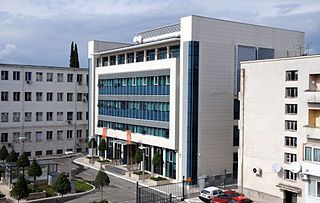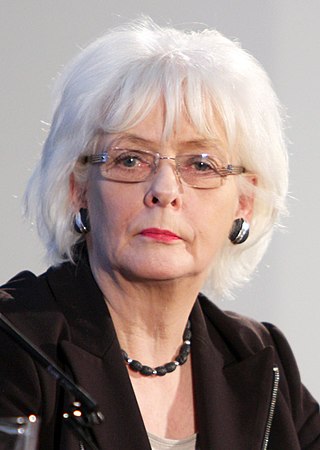Minister of labour or labor is typically a cabinet-level position with portfolio responsibility for setting national labour standards, labour dispute mechanisms, employment, workforce participation, training and social security.
A health minister is the member of a country's government typically responsible for protecting and promoting public health and providing welfare and other social security services.

The Ministry of Health, Welfare and Sport is the Dutch Ministry responsible for public health, health care, quality of life, social work and sport. The Ministry was created in 1951 as the "Ministry of Social Affairs and Health" and had several name changes before it became the "Ministry of Health, Welfare and Sport" in 1994. The Ministry is headed by the Minister of Health, Welfare and Sport, currently Conny Helder (VVD), assisted by one State secretary, currently Maarten van Ooijen (CU).

The Ministries of Japan or Government Agencies of Japan are the most influential part of the executive branch of the Government of Japan. Each ministry is headed by a Minister of State appointed by the Prime Minister. In postwar politics, the posts of ministers have been given to senior legislators, mostly of the LDP. However, few ministers serve for more than one or two years to develop the necessary grasp of the organisation to become really influential. Thus, most of the power lies within the ministries, with the senior bureaucrats.
The Cabinet of Malaysia is the executive branch of the Government of Malaysia. Led by the Prime Minister, the cabinet is a council of ministers who are accountable collectively to the Parliament. According to the Article 43 of the Federal Constitution, members of the Cabinet can only be selected from members of either houses of Parliament. Formally, the Yang di-Pertuan Agong appoints all Ministers on the advice of the Prime Minister. The constitution is amended by repealing the Clause (8) of Article 43, enabling a person who is a member of State Legislative Assembly to continue to serve even while serving as a minister or deputy minister in the cabinet. Ministers other than the Prime Minister shall hold office during the pleasure of the Yang di-Pertuan Agong, unless the appointment of any Minister shall have been revoked by the Yang di-Pertuan Agong on the advice of the Prime Minister but any Minister may resign from office. In practice, the Yang di-Pertuan Agong is obliged to follow the advice of the Prime Minister on the appointment and dismissal of ministers.

The Danish Ministry of Health is a Danish governmental ministry responsible for healthcare policy in Denmark. First created as an independent ministry in 1926, it has at various times been combined with the Ministry of the Interior as the Ministry of Interior and Health, most recently in 2022-, and has had various names. The current Minister for Health is Sophie Løhde, and the Permanent Secretary since 11 January 2021 is Svend Særkjær.
The Ministry of the Interior is one of the oldest government ministries in Denmark, having been established in 1848, but has frequently been combined with other ministries. Since 2015 it has been part of the Ministry of Social Affairs and the Interior. Its primary task has been to ensure the state's oversight over the regions and communities; it also oversees elections.

The Government of Montenegro is the executive branch of state authority in Montenegro. It is headed by the prime minister. It consists of the prime minister, the deputy prime ministers as well as the ministers.
Karen Moustgaard Jespersen is a Danish journalist and former politician representing the party Venstre.

The Ministry of the Interior and Kingdom Relations is the Netherlands' ministry responsible for domestic policy, civil service, public administration, elections, relations with local governments, intelligence, and kingdom relations.

The third Cabinet of Danish Prime Minister Anders Fogh Rasmussen was announced on 23 November 2007.
The Danish Ministry of Social Affairs was re-created in 2010 as a split of the Social Welfare ministry created after the 2007 Folketing elections. The split moved the section that had to do with the Ministry of the Interior off into the Ministry of the Interior and Health. The current minister is Pernille Rosenkrantz-Theil.

The Ninth Government of the Republic of Croatia was the first of two Croatian Government cabinets led by Prime Minister Ivo Sanader. It was announced on 23 December 2003 and its term ended on 12 January 2008. All but two cabinet members came from the ruling Croatian Democratic Union (HDZ) party, following their win in the 2003 parliamentary elections.

The First cabinet of Lars Løkke Rasmussen, was announced on 5 April 2009 as Lars Løkke became prime minister after Anders Fogh Rasmussen was offered the post of Secretary General of NATO on 4 April 2009.
The Ministry of Welfare is an Icelandic cabinet-level ministry founded 1 January 2011. It is the result of the merger of the Ministry of Social Affairs and Social Security, founded 17 April 1939 as the Ministry of Social Affairs and the Ministry of Health, founded 20 November 1959. It is responsible for administration and policy making of social affairs, health and social security. The first Minister of Welfare was Guðbjartur Hannesson. As of November 2017, there are two ministers heading the Ministry of Welfare: Ásmundur Einar Daðason, Minister of Social Affairs and Equality, and Svandís Svavarsdóttir, Minister of Health.

The Second cabinet of Jóhanna Sigurðardóttir in Iceland was formed 10 May 2009. The cabinet left office on 23 May 2013.

The first cabinet of Iuliu Maniu was the government of Romania from 10 November 1928 to 6 June 1930.
This page is based on this
Wikipedia article Text is available under the
CC BY-SA 4.0 license; additional terms may apply.
Images, videos and audio are available under their respective licenses.











